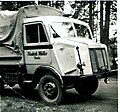Trailer triangle


The trailer triangle is a warning sign in road traffic . The mostly foldable yellow triangle with a black border is attached to the front center of the roof of the towing vehicle and is intended to indicate to the oncoming or crossing road users that a trailer is being carried.
purpose
The trailer triangle signals from the front or from across the road that a vehicle is driving as a trailer and has special needs and driving characteristics.
- A trailer train sometimes brakes less quickly. In 1938, there were only trailers that were braked by hand, with brakes on the vehicle if necessary.
- A trailer train tends to get into the inside of the curve with the drag curve of the last axle.
- A trailer train is more likely to turn left, sweeping to the right.
- A trailer train tends to buckle when braking hard, so that the trailer stands more or less sideways.
- A trailer train is much more difficult to reverse, so at a narrow point it is more likely to be given the right of way over oncoming traffic that arrives without a trailer.
history
The trailer triangle was prescribed in Germany ( German Reich and then in the Federal Republic of Germany and the GDR ) from April 1, 1938 to 1956 in Section 44 of the StVZO .
For Austria, which had been "annexed" to the German Reich only 19 days before - on March 13, 1938 - this provision probably also applied. After the Second World War (until 1945) and the occupation (until 1955), the StVO was revised in 1960 in reborn Austria , which was valid from the beginning of 1961. The trailer triangle was no longer included, but it was also not prohibited. On older trucks, such as furniture vans and construction vehicles, trailer triangles were seen more frequently until 1970, folded or raised, rather independent of the presence of a trailer, but hardly ever illuminated.
Accordingly, from April 1, 1938, a yellow foldable triangle with a side length of 18 cm had to be present on the driver's cab roof as a so-called trailer triangle . The illuminated triangle had to be recognizable for all trips with the trailer in the unfolded state in the dark for at least 100 m.
On March 21, 1956 there was a new regulation of the StVZO, unofficially called the " Seebohm'schen Laws ", and the trailer triangle was then no longer permitted for new vehicles ( trucks , tractors , buses and trolleybuses with trailers as well as double trolleybuses ). Similar facilities were previously found in other European countries.
description
It was a foldable yellow triangle with a black border and interior lighting on the driver's cab or cab roof, which had to be set up when a trailer was being used in order to signal the danger from the trailer (or trailers) to oncoming vehicles . Older versions had a bracket with one joint each on the left and right, later a bracket with only one joint attached to the center of the triangle base . For bus trailers , the triangle was white with a red border, similar to a danger sign .
Simple, early versions had to be folded up manually from the outside by climbing up sufficiently on the side of the bonnet or on the front control arm. Push-through triangles with a folding mechanism that could be operated from inside the cabin with a rotary lever prevailed later.
There were similar regulations in Austria (see above), France , Italy , the Netherlands , Sweden and the Soviet Union . While the Austrian and Dutch versions hardly differed from the German version, the other versions were designed differently and often not illuminated from the inside. There were also versions with a triangle on a square or circular background.
In Spain , cars used to have to be provided with a square sign (usually without lighting) with a black border on which a yellow triangle on a square blue background could be seen when carrying a trailer.
gallery
German version
Horch / IFA H3 in the GDR in solo operation with folded trailer triangle (1953)
MAN F8 furniture van from Germany with a trailer triangle from 1957
Minol tank truck on IFA S4000 from the GDR with a trailer triangle
Saurer truck with all-wheel drive from the 1950s in a version for the FRG with a trailer triangle
French version
Half-track vehicle SOMUA MCG 5 from the year of construction 1939 with a square trailer triangle
Italian version
Fiat 634N from the early 1930s with a trailer triangle in the old Italian version
Swedish version
Demarcation
The triangular trailer should not be confused with the triangular reflectors on trailers that are mandatory EU-wide , as shown in the adjacent picture.
See also
- Winker - another historical illuminated signal system
Web links
Individual evidence
- ↑ PKP-modelarz: Article Drehscheibe-online.de, 06 - Modellbahn-Forum, posted September 8, 2016, accessed March 20, 2020.
- ↑ See § 44 StVZO of November 13, 1937.
- ↑ § 72 (2) StVZO transitional provisions to § 44 StVZO.
-
↑ Trucks - history, technology, types. GeraMond-Verlag, Munich 2007, ISBN 978-3-7654-7804-8 , p. 38.
+ 80 years of Lastauto Omnibus. Special issue of Lastauto Omnibus magazine . P. 105.








